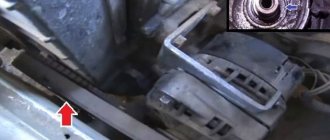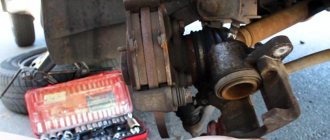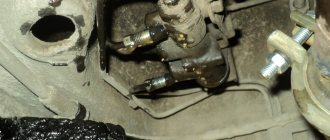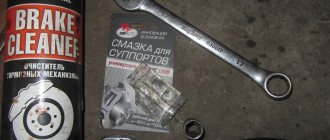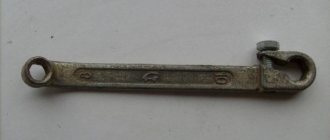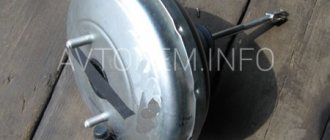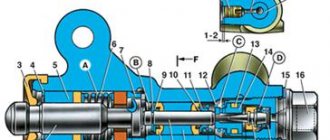Probably no one needs to explain the importance of a car's braking system to ensure maximum safety while driving. The system consists of many elements, each of which performs a function. Today we will dwell in detail on such a detail as the front brake cylinder for the VAZ 2114 . Structurally, the element is located in the brake caliper (right and left).
Inside the unit there are pistons, which, when you press the brake pedal, are activated under the pressure of the brake fluid and press on the pads. The latter rest against the brake disc, thereby preventing the rotation of the front wheels.
Replacing the front brake cylinder on a VAZ 2114
- To gain access to the work area, first remove the wheel on the side where you want to replace it.
- After removing the wheel, use a hexagon to loosen the brake caliper cylinder. To do this, you need to slightly unscrew two bolts, one on top, the other on bottom.
- Unscrew and disconnect the brake hose. To prevent liquid from leaking out of it, lift it vertically, or insert a sealed plug into the passage hole.
- Next, using a flat-head screwdriver, pry up the fastening washers and use an adjustable wrench to unscrew the next 2 bolts.
- Now the cylinder body can be easily detached along with the bracket.
- Fully unscrew the previously loosened hexagon bolts. We disconnect the bracket from the body of our product.
- Reinstallation is done in the same order, except that the brakes will need to be bled. This must be done in order to remove accumulated air from the system.
Welcome! Front brake cylinders - there are only two of them, each of their cylinders is located in a brake caliper, their real name is: “Brake wheel cylinders”, their operating principle is as follows: when you press the brake pedal, the fluid presses on the pistons, which are located in the brake cylinders, and the pistons in the meantime, the pads are pressed against the brake disc, when the foot is removed from the brake pedal, the fluid returns and the pistons stop applying pressure to the brake pads (Braking stops).
Note! To carry out the work, stock up on: Wrenches, copper O-rings for brake hoses (take about 4), as well as brake fluid, something to plug the brake hose with, hex heads, different types of screwdrivers, and spanners and of course, the tools needed to remove wheels from a car!
Summary:
Where is the brake cylinder located in the caliper? The easiest way to see the cylinder is when the caliper is removed from the car, but by simply pulling out the brake pads, the cylinder can be fully seen, the cylinder itself is sold and replaced as an assembly, it consists of several but very important things, firstly, the piston is located inside the cylinder and walking back and forth, thereby pressing and moving the brake pads away from the disc and of course the cylinder has a bleeder fitting, it is closed with a cap in the small photo with a blue arrow and the last element is indicated, this is the boot at the piston of the brake cylinder, it is indicated with a green arrow, thanks to it, the brake fluid is not squeezed out and into the cylinder, dirt, sand and moisture do not get in, they are very destructive for the cylinder and if they get inside, they will wash out all the lubricant (If it is water) or the lubricant will mix with sand (If sand gets in into the cylinder), and as a result the piston will barely move (braking efficiency will therefore drop).
- Replacing the main brake cylinder of a VAZ 2114
When should a brake cylinder be replaced? The cylinder can be changed as an assembly, or it can be repaired by replacing parts in it such as the piston and boot separately, but we do not recommend going down this path, because firstly, the assembled cylinder does not cost that much money, but secondly, if you assemble something incorrectly (for example, don’t fasten the pin well), it will fly off and the brake fluid, if it’s missing, will all leak out (you’ll be left without brakes), so it’s better to change the entire assembly, the signs that indicate that the cylinder needs to be replaced are as follows: The bleeder fitting has broken and you cannot unscrew it in any way, also if the boot is torn, the cylinder must be replaced, if the piston in the cylinder becomes sour (This happens from time to time), it will also need to be replaced, but the piston can become sour in different positions, namely in braking mode (The wheel will constantly brake) or in its calm state (This wheel will not brake at all and the car will pull to the side when braking).
How to replace the brake cylinder on a VAZ 2113-VAZ 2115?
1. Remove the wheel first from the side on which you will change the cylinder (Read the article on “Replacing wheels on modern cars”, it describes how to remove the wheels correctly), when the wheel is removed, remove the brake hose from the bracket to which it is attached (the location is indicated by a red arrow) and using a wrench, tear off the nut that secures the brake hose to the brake cylinder (see small photo).
2. Now the brake caliper bracket assembly with the cylinder will need to be removed, to do this you will have to unscrew two bolts, but when unscrewing them, hold the guide pins with a second key so that the bolts in the guides do not turn (see photo 1), after which the bolts are removed from the guide pins and the bracket assembly with the brake cylinder is removed from the caliper, but the bracket cannot be completely removed, and the fault is the brake hose, which will have to be disconnected from the brake cylinder. To do this, completely unscrew the hose mounting nut (While unscrewing, hold the nut with a wrench and rotate the caliper assembly in the brake cylinder by hand, counterclockwise) and disconnect the hose, as soon as you disconnect it, immediately plug the hose with some kind of plug so that the brake fluid does not pour out through it, then firmly tighten the brake cylinder with the caliper you need a vice, but you can do without them, in general you will have to unscrew the two bolts that attach the brake cylinder to the caliper, they need to be unscrewed with a hex key or hex heads, after unscrewing, the caliper and the cylinder must be separated.
Note! When the brake hose is disconnected from the cylinder, the copper o-ring will fall, you don’t have to worry about it at all and don’t look for it on the floor, because this ring will need to be replaced with a new one!
3. A new front brake cylinder is installed in the reverse order, the copper rings must be replaced with new ones. If you decide to try to repair the brake cylinder, then in this case, read the article entitled: “Repairing the caliper on a VAZ 2109.”
Note! We also recommend that you lubricate the brackets assembled with the brake cylinder and the guide fingers of the bolts before installing them; you need to lubricate them by removing the boot from them, as shown in the photo below, lubricate the fingers with UNIOL-1 grease, when you assemble everything, bleed the brakes on a family car with an assistant Samara 2, detailed bleeding instructions, are on our website under the title: “Bleeding brakes on a VAZ 2114”!
Additional video clip: Below is a video about replacing the brake cylinder with a new one, familiarize yourself with it and you will clearly understand how to replace it.
Note! If you don’t yet know how the brake system works and works, then in this case, be sure to study the interesting video that we posted just below, after watching it, you will immediately understand why brake fluid is needed and why the car stops braking when the fluid pours out!
https://www.youtube.com/watch?v=Av-jj8NNrv8
- VAZ 2110, 2112, 2111 replacement of the front brake cylinder, photo and video instructions
Disassembly and assembly of the front brake mechanism VAZ 2114, VAZ 2115, VAZ 2113, Lada Samara 2
Disassembling the front wheel brake mechanism
Unscrewing the cylinder mounting bolt: 1 – cylinder mounting bolts; 2 – cylinder; 3 – bolts connecting the cylinder with the caliper
Details of the brake mechanism of the front wheel of Lada Samara 2: 1 – wheel cylinder; 2 – fitting for bleeding the brake drive; 3 – sealing ring; 4 – piston; 5 – protective cap; 6 – retaining ring; 7 – caliper; 8 – pad guide; 9 – brake pads; 10 – protective cover; 11 – guide pin; 12 – guide pin fastening bolt; 13 – brake hose; 14 – bolt securing the cylinder to the caliper
Disconnect the hose from wheel cylinder 2. Unlock and unscrew bolts 1 securing the wheel cylinder to the guide pins, holding the guide pin by the edge with a wrench. Remove the 8 pad guide assembly with pins. Remove the brake pads of the VAZ 2113 VAZ 2115.
Pushing the piston out of the cylinder
Remove the lock ring 6 and the protective cap 5 from the cylinder and piston. Carefully push a stream of compressed air through the fluid inlet to push the piston out of the cylinder. To avoid damaging the piston on the surface of the caliper when pushing it out, install a wooden pad under the piston. Unscrew the bleeder fitting from the cylinder body and carefully inspect the working surface of the cylinder. There should be no scoring, damage or corrosion.
Front wheel brake assembly
Assemble the brake mechanism of the VAZ 2114 in the reverse order of disassembly. In this case, it is recommended to replace O-ring 3 and cap 5 with new ones. Lubricate the cylinder mirror, piston 4 and the sealing ring with brake fluid, and apply graphite grease or Ditor grease to the surface of the piston, install the piston in the cylinder and, without removing any remaining grease, put on the protective cap 5 so that its edges fit into the groove of the piston and cylinder, then install retaining ring 6. Lubricate the guide fingers with UNIOL-1 grease (1.5 g for each finger). Tighten the bolts securing the caliper and cylinder to the pins to the torques specified in Appendix 1, then lock them. Before tightening the bolts, apply sealant to them to prevent corrosion of the threaded part of the connection. After assembling and installing the brake mechanism, restore the fluid level in the reservoir and bleed the hydraulic drive system of the VAZ 2114.
The device of the VAZ brake system
The brake system of Togliatti-made cars is quite simple; the vehicle consists of the following main parts:
- pedals, which are pressed to achieve braking;
- brake master cylinder (MBC), it transmits the force of pressing the pedal through hydraulics to the working cylinders, respectively, to the wheels. GTZ VAZ - dual-circuit, the circuits are divided to transmit fluid pressure to the front and rear wheels;
- a vacuum booster that makes it easier to press the pedal;
- tubes that connect the elements of the vehicle;
- brake working cylinders (RTC);
- pads (drums) and discs;
- brake distributor (pressure regulator).
When you press the brake pedal, the piston in the brake fluid compressor compresses the brake fluid and transmits its pressure to the brake pedal. The pistons of the working cylinders are expanded under the influence of hydraulics, moving the pads towards the discs or drums. The movement of the wheels slows down, and thus the car slows down.
How to determine the moment of replacement?
The operation of the brake system as a whole can be affected by many different components that have a malfunction. But each element has its own individual characteristics, by which one can “calculate” this or that problematic detail. It is quite easy to track problems that are specific to the brake cylinder system; here are some of them: 1. Soured piston. This is a fairly common phenomenon on cars with high mileage and service life. Indirect signs indicating this problem are stalling of the drive wheels (the piston is jammed and it constantly presses on the block) or the brake does not work when the pedal is pressed. 2. Damage to the seal or breakage of the fitting or boot (brake fluid may leak out in various volumes).
If you notice the above symptoms, immediately carry out a thorough diagnosis.
Self-repair or purchase of a new unit
Let's start with the fact that incorrect or poor-quality repair of the front brake cylinder of a VAZ 2114 can lead to disastrous consequences, so if you are not a professional auto mechanic, we do not recommend doing the work yourself! In addition, the meaning of repair is not always justified for the following reasons: 1. The cost of the assembled part is affordable for most car enthusiasts. 2. When using an old, modified (repaired) product, there is a high probability that the unreplaced, worn parts will fail at the most inopportune moment. Therefore, the most rational, safe, and correct solution is to completely replace the unit.
Malfunctions occurring in the brakes
From time to time, various malfunctions occur in the vehicle, and the working and master cylinders also often fail. The following breakdowns occur at the RTC:
- the piston gets stuck in one of the positions;
- the inner surface wears out;
- The sealing cuffs fail (tear or swell).
The main sign of a faulty condition is the appearance of smudges (leaks) of brake fluid (FL) from the RTC. If the pads are worn down to bare metal, the pistons in the RTC extend too far, and as a result, the brake fluid may leak and the brakes will fail.
In the GTZ, the piston can also jam, the internal cavity of the mechanism can wear out or rust, and the cuffs can leak. Symptoms of a GTZ malfunction are as follows:
- when braking, the brake pedal (BP) “fails”, the effectiveness of pressing disappears, this usually happens when there is a small leak from the turbocharger;
- braking occurs at the very end of the pedal stroke, and you have to press the PT several times to brake;
- there are no brakes on the front or rear wheels, this happens if one of the GTZ circuits does not work.
You cannot drive with faulty working and master brake cylinders; the parts should be replaced immediately.
FAULTS
Symptoms of a malfunctioning TTS:
- The brake fluid leaves the reservoir;
- The rear drum is wet, fluid leakage is noticeable;
- The braking efficiency has disappeared, the pedal “takes” at the very end of the stroke, sometimes not from the first stroke.
Reasons for inoperability:
- Natural wear and tear;
- The cuffs are corroded due to mixing different types of brake fluid;
- Poor quality of the part;
- The pistons were squeezed out due to severe wear on the pads.
It happens that the pistons inside the housing become jammed. If this happens with the pistons spread apart, the car begins to constantly slow down and the drum overheats. You cannot drive with such a defect; the car must be urgently repaired.
There is one nuance that is worth focusing on. Often, when bleeding the brakes, mechanics break off the bleeder fitting on the cylinder when trying to unscrew them.
Even WD-40 doesn't help. This happens due to the fact that over time, the “pumping” begins to boil in the ZTC body. Therefore, before bleeding the brakes, you should have a supply of new replacement parts.
There is also a tricky way that will help you avoid breaking off the fitting. Before unscrewing, you must carefully (do not break the fitting with a hammer!), but thoroughly tap the housing around the bleeder fitting and try to move it out of place.
After this, without using much effort, we try to weaken the “pumping”. Doesn't work? Then tap again. Most likely, patience will be rewarded, and problems associated with unscheduled cylinder replacement will not arise.
Replacing the master brake cylinder
Replacing the GTZ on VAZ classic cars (2101-07) is not difficult; you can do this work yourself. To perform such an operation you will need the following tool:
- Replacing the rear brake cylinder
- 10mm wrench (or special bleeder wrench);
- Phillips screwdriver;
- combination wrench for 13 (you can additionally use a head with a knob and a ratchet for convenience).
It is not necessary to use a pit or a lift to perform the work; replacement can be done outside in dry weather or in the garage. The work should be performed in the following sequence:
- unscrew the three brake pipes from the bottom of the device (key for ten);
- loosen the clamps of the two hoses (at the bottom of the GTZ), pull off the hoses;
- unscrew the two nuts securing the GTZ to the vacuum booster (you need a 13mm wrench or a socket with a wrench);
- We dismantle the part, install the new gas turbine unit in place, and reassemble it.
After the operation, you should add fluid to the vehicle reservoir, then be sure to bleed the brakes well.
Replacing brake cylinder 2114
The work of replacing the GTZ on VAZ 2108-15 models is carried out approximately the same way, there are only some design differences.
We make the replacement as follows (using the example of the VAZ-2114):
- Unscrew the four tubes on the sides (two on the left and two on the right). It is better to use a special pipe wrench; you can roll up the edges of the nuts with an open-end wrench;
- unscrew two thirteen nuts securing the GTZ to the “vacuum”;
- We remove the old spare part and install a new one, not forgetting to bleed the brakes at the end of the work. At this point, the replacement of cylinder 2114 can be considered complete.
If in the GTZ 2114 the inner surface of the cylinder itself is not yet worn out, you can replace the insides of the mechanism by installing a new repair kit. The repair kit consists of four cuffs:
- three cuffs are the same, they are the same as on models 2101-07;
- one o-ring 2108.
Changing the repair kit is very simple:
- pour the liquid out of the GTZ;
- dismantle the plastic tank;
- unscrew the front stopper (made in the form of a plug);
- we take out all the contents (pistons, o-rings, springs), change the cuffs, and install the entire mechanism in the reverse order. Nothing should be mixed up here, otherwise the unit being repaired will not work.
Repairing the GTZ on VAZ models is not always advisable - if the mirror surface inside the mechanism is worn out, replacing the brake cylinder repair kit will not solve the problem, the GTZ will also leak. Most often, on VAZ cars, the entire master brake cylinder is replaced - a new assembled part costs around one thousand rubles, and the repair turns out to be unjustified.
Diagnostics and repair - replacement of repair kit
Where to start diagnosing the brake system and GTZ? First of all, it is necessary to carry out a visual inspection, since any damage - drips, wet spots on the body, cracks, etc. - are very alarming signs. Are there any external defects found? Then you should check the brake pedal travel, it should be smooth and soft, jamming and failure are unacceptable. If everything is in order, then the next step is to test the braking system in action. You can check the dismantled master brake cylinder for leaks only at a service station or if you have a special stand. All its elements are treated with alcohol, and for rubber gaskets only replacement is suitable. Pay special attention to the GTZ mirror; chips, scratches and other damage are not allowed on it.
If damage incompatible with life is detected, you can replace the brake master cylinder repair kit yourself. Naturally, the first thing to do is dismantle the part. It is installed in the engine compartment housing. Having reached the unit, drain the brake fluid; to do this, you need to pry off the corresponding clamps with a screwdriver and pull out the pipes. After which the studs are unscrewed and the GTZ can be freely removed.
Replacing brake cylinder 2107
If the replacement operation on a VAZ classic is not performed on a car lift, it is more convenient to do the work sequentially - first on one side, then on the other side of the rear wheel. To perform the work, the vehicle must be placed on a level surface, then proceed as follows:
- We turn off the engine, set the car to speed, and put chocks under the front wheels. Don’t forget to fully release the handbrake;
- loosen the wheel nuts of the rear wheel, jack up the car and remove the wheel;
- To prevent the car from going anywhere, it is advisable to place a “tragus” next to the jack;
- remove the brake drum - use a 12 mm combination wrench to unscrew the two guides;
- the drum usually comes off tightly, so it should be tapped from behind with a hammer through a piece of wood. You cannot hit the part with an iron hammer; the drum can split;
- unscrew the brake pipe from behind the cylinder, also 2 ten bolts securing the RTC itself;
- pull out the cylinder, freeing it from the pads;
- We install the part prepared for replacement (it is important to get the pads into the slots on the RTC pistons, we fasten all the removed parts in their places;
After the work has been done, it is necessary to top up the fuel injection system reservoir and bleed the brakes.
Simple step-by-step instructions for installing rear disc brakes
Step 1
We loosen the tension of the cables and bring the rear pads together, then use a 12mm wrench to unscrew the guide pins. Use a metal brush to clean the seat and carefully knock down the brake drum. I recommend using a rubber mallet to avoid damaging anything. Truly super tuning of a VAZ 2114 car requires patience and strength. Using a screwdriver, pry up the spring that tightens the pads and remove it. We pull out the spacer bar and take out the upper tension spring. After this, remove the brake pad, first lowering the handbrake lever.
Step 2
When all the old parts have been removed, you can begin installing the HCD. Decide how you want the caliper to be placed - behind or in front of the axle. The effectiveness of the brakes will not change in any way from this operation. I put the axles behind. This is more symmetrical and the weight of the brake mechanism will help with braking. Now you need to join the hub and faceplate into one piece. This operation should be taken seriously. It will be useful to watch a video on this issue, where domestic masters show their tuning of Russian cars in order to share their experience and show some of the intricacies of performing this work. The centering process must be carried out very carefully.
Step 3
Now you can straighten the corners of the beam before placing the hub combined with the faceplate on the beam. This must be done so that the corners do not interfere with the caliper. Personally, I flattened them with a hammer. This work can also be done using a grinder. You should not install a grinder under the left hub bolt, otherwise you will have to work with the grinder again and file the head of the bolt. The brake caliper bracket may rest against it.
Step 4
Well, now the most important thing. We install the bracket on the faceplate and put the brake disc on the hub. Place spacers at the connection points. This must be done at connection points. It happens that the size of the washers may differ, then you need to buy them for a specific car, in our case it is tuning a 14 model car. We tighten the faceplates and the connection of the brackets (I recommend doing this with a force of 3-4 N.M). We screw the hose to the caliper, install the pads, and you can close the tube sealing line. Now we seal the brake line. We check the line for leaks by pumping up the pressure with the pedal. If everything works as it should, then you can begin installing the HCD on the other side.
Source
Replacing the brake cylinder VAZ 2109
The RTC on the rear axle of the 2109 wheels is changed according to the same principle as on the VAZ classic; the wheel and drum are also removed, the tube and two cylinder fastenings are unscrewed with a ten key. It often happens that the tube and RTC bolts on the support disk boil; to remove them carefully, you need to spray the connections with WD-40, and wait 15-20 minutes before unscrewing. The brake pipe nut will be easier to unscrew if you gently tap the metal around it with a hammer. When tapping, it is important not to break the bleeder fitting.
Replacing brake cylinder 2109 is not a difficult task, and many drivers can do this work themselves.
Replacing the front brake cylinder
The following calipers are installed on the front wheels of VAZ cars:
- in a VAZ classic car, two front brake cylinders (FTC) are attached to the caliper brackets;
- on VAZ 2108-15 models, one PTC is installed on each side of the front axle.
Replacing the front cylinder 2109 is not difficult, it is also easy to do yourself:
- we put the car on a flat area (the work can be done without a pit and a lift), we put tackles under the rear wheels;
- jack up the car, take off the front wheel;
- unscrew the two caliper fasteners with a hexagon;
- loosen the brake hose nut;
- bend the locking washers on the upper and lower bolts, unscrew the cylinder fastenings to the caliper bracket
- we move the PTC to the side along with the bracket;
- disconnect the cylinder from the bracket, then from the hose so that the brake fluid does not leak; after disconnecting the PTC, it is better to immediately direct the hose upward;
- we install another, new spare part, and perform the assembly.
Replacing the brake cylinder VAZ 2101-07
On VAZ classic cars, the PTC changes a little differently than on front-wheel drive VAZ cars. The front caliper on the “Classic” can be changed as a whole assembly, but it is also possible to replace only the cylinders. The work is carried out as follows:
- We also put the car on the platform, remove the front wheel;
- unscrew the bolts securing the caliper itself;
- move the caliper to the side, disconnect the hose;
- We take out the pads from the caliper and twist the brake pipe from it.
- if the pins for securing the pads cannot be removed, they will have to be cut with a grinder, then installing new fasteners;
- the brake cylinders are mounted on a bracket in the guides, and they are removed either with a pry bar or by gently tapping with a hammer;
- we install other cylinders, a tube and pads with pins, and complete the assembly.
Installation details and purchasing spare parts
So, it's time to start installation. The first step is to unscrew the brackets, cylinders and guides. Typically, new discs have a large central hole (CO), and therefore, for correct operation and accurate centering, I would advise cutting a strip from a tin beer can, which must be inserted between the hub and the disc to eliminate play. After this operation, you can put on the disc and screw on a new bracket. Diagnostics of the car's brake system must be performed without fail.
Replacing the brake cylinder cuff
If desired, on VAZ cars you can not change the entire rear working cylinders, but only replace the cuffs. To do this, you need to disassemble the RTC - remove the pistons and spring, remove the old cuffs from the pistons and install new ones. It is advisable to repair the RTC only if the cylinders did not last long, but they began to leak. The thing is that on VAZ cars the RTCs are very inexpensive, it is advisable to change the rear cylinders as a whole - replacing the cuffs is often unjustified.
Causes of breakdowns and their symptoms
One of the main reasons for brake master cylinder failure is uneven distribution of fluid in the system, leading to circuit failure. The wear of the sealing collars located at the points where the rod enters the cylinder has a negative effect. It is also possible that scuffs may appear on the pistons and deformation of their return springs with rubber cuffs.
In addition, the compression hole becomes partially or completely clogged. The above malfunctions can be caused by poor-quality brake fluid. Any failed part should be urgently dismantled and a new one installed in its place; if the cylinder mirror is faulty, the entire assembly must be replaced. Moreover, you cannot hesitate, since the correct operation of the gas turbine engine is one of the keys to your safety.
Much can be understood by the performance of the brake pedal. So, if it has a reduced stroke, then most likely the reason lies in the compression hole. It may be clogged or blocked. It may also be due to the lack of clearance between the gas turbine seal and the piston. When the piston gets stuck, the channels are blocked and the cuff is deformed, the pedal does not make a full stroke. But if it moves too easily, then the cause is a hydraulic fluid leak, and the rubber bushings need to be replaced. Sticking of the piston is indicated by the wheels braking when the pedal is released.
Some tips
- If you start having problems with the brakes, first of all you need to carry out an external inspection of the vehicle: check the fluid level in the reservoir, make sure that the front/rear cylinders are not leaking. There should not even be stains of brake fluid in the brake hydraulics.
- “Brake fluid” must be filled with the same brand; it is recommended to completely replace the brake fluid at least once every two years.
- If faults are identified in the gas turbine engine, and it has already served for at least a year, it is more advisable to replace it completely than to repair it. The same can be said about the rear working cylinders.
- Before changing the turbocharger, the brake fluid should be removed from it; this operation is usually done using a syringe.
- Usually a leak in the master cylinder is not visible, but if there is any suspicion that this part is faulty, you should remove the main cylinder - there will be traces of leaks at the rear, and this indicates its faulty condition.
- If, during an external inspection, cracks were found on the brake hoses, it is better not to take risks and immediately replace the defective parts.
Didn't find the information you are looking for? on our forum.
If you find an error, please select a piece of text and press Ctrl+Enter.
We recommend reading:
How to set the ignition on a VAZ 21213 carburetor with your own hands Camshaft play on a VAZ 2110, 8 valves, eliminate knocking yourself High engine speeds at idle on a VAZ 2109 injector How much engine oil is in a VAZ 2114 The tachometer on a VAZ 2110 injector does not work reasons The battery light is on on the instrument panel of a VAZ 2110, reasons and how eliminate VAZ 2114 how to reset daily mileage on VAZ 2109 battery charging lamp is dimly lit but charging is in progress
Expert advice
- Before installing the parts, it is advisable to wipe them with alcohol and wipe them with a rag.
- It is undesirable to allow parts to come into contact with fuels and lubricants, as they corrode the seals.
- After replacing the turbocharger, it is imperative to bleed the hydraulic brakes, since without bleeding the system, air will remain in it, which will negatively affect the operation of the car.
- If the O-rings are in good condition, they should still be replaced during removal.
The most common cause of failure of the turbocharger is brake fluid leakage. In order to find and eliminate it in a timely manner, it is necessary to periodically monitor the joint of the brake cylinder.

